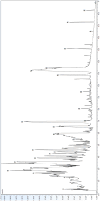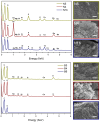Unveiling the Composition of La Pajarita PVAc-Based Paints in Joan Miró's Studio and in Three Artworks from the 1970s
- PMID: 39599237
- PMCID: PMC11597971
- DOI: 10.3390/polym16223146
Unveiling the Composition of La Pajarita PVAc-Based Paints in Joan Miró's Studio and in Three Artworks from the 1970s
Abstract
In this study, we present the first characterisation of the polyvinyl acetate (PVAc) paints of commercial Spanish brand La Pajarita preserved in the studios of Joan Miró (1893-1983) in Mallorca, Spain. Investigation of several black and white paint samples using complementary analytical techniques (XRD, SEM-EDX, FTIR, and Py-GC-MS) allowed for the identification of pigments and binding media in studio materials, as well as in three artworks dating from the 1970s. Through comparative analysis, it was possible to find significant similarities between the composition of La Pajarita paints conserved in cans in the artist's studio with black and white painted layers from three artworks by Miró. Miró's use of La Pajarita paints is extensively documented in studio notes, photographs, and videos, and these paints are known to have been used by other significant Spanish artists. However, their composition has remained largely undiscovered until now. This research contributes to the knowledge of PVAc paints, providing evidence of their use by Joan Miró. The analytical results serve as a valuable reference for comparing and identifying these synthetic paints in other artworks, as well as aiding in attribution or dating studies. Furthermore, the study demonstrates the significance of materials found in artists' studios as a fundamental resource for identifying the materials present in artworks.
Keywords: 20th century artworks; Fundació Miró Mallorca; Joan Miró; La Pajarita; PVAc; Py–GC–MS; artist materials; artist studio; latex paints; vinyl paints.
Conflict of interest statement
The authors declare no conflicts of interest.
Figures







Similar articles
-
Photochemical degradation study of polyvinyl acetate paints used in artworks by Py-GC/MS.J Anal Appl Pyrolysis. 2012 Sep;97(5):158-163. doi: 10.1016/j.jaap.2012.05.004. J Anal Appl Pyrolysis. 2012. PMID: 23024446 Free PMC article.
-
Identification of additives in poly(vinylacetate) artist's paints using PY-GC-MS.Anal Bioanal Chem. 2010 May;397(1):357-367. doi: 10.1007/s00216-010-3505-2. Epub 2010 Feb 23. Anal Bioanal Chem. 2010. PMID: 20177664
-
Study of behaviour on simulated daylight ageing of artists' acrylic and poly(vinyl acetate) paint films.Anal Bioanal Chem. 2011 Mar;399(9):2921-37. doi: 10.1007/s00216-010-4294-3. Epub 2010 Oct 28. Anal Bioanal Chem. 2011. PMID: 20981537
-
Poly(Vinyl Acetate) Paints: A Literature Review of Material Properties, Ageing Characteristics, and Conservation Challenges.Polymers (Basel). 2023 Nov 7;15(22):4348. doi: 10.3390/polym15224348. Polymers (Basel). 2023. PMID: 38006073 Free PMC article. Review.
-
Review of recent advances on the use of mass spectrometry techniques for the study of organic materials in painted artworks.Anal Chim Acta. 2023 Mar 15;1246:340575. doi: 10.1016/j.aca.2022.340575. Epub 2022 Nov 3. Anal Chim Acta. 2023. PMID: 36764767 Review.
References
-
- Freixa J. Miro Fundació Pilar i Joan Miró a Mallorca. Lunwerg Editores; Barcelona, Spain: 2005. L’estudi per a Joan Miró a Mallorca: Assaig per a un futur millor; pp. 36–43.
-
- Bestard B. Miro Fundació Pilar i Joan Miró a Mallorca. Lunwerg Editores; Barcelona, Spain: 2005. Son Boter; pp. 44–49.
-
- Russell J.E., Singer B.W., Perry J.J., Bacon A. Investigation of the materials found in the studio of Francis Bacon (1909–1992) Stud. Conserv. 2012;57:195–206. doi: 10.1179/2047058412Y.0000000008. - DOI
-
- Bustin M. Towards Interpretation of Making, Meaning, and Change in British Twentieth Century Oil Paintings: The Relevance of an Artist’s Paint Archive. In: van den Berg K.J., Burnstock A., de Keijzer M., Krueger J., Learner T., de Tagle A., Heydenreich G., editors. Issues in Contemporary Oil Paint. Springer International Publishing; Cham, Switzerland: 2014. pp. 33–43.
-
- Izzo F.C., Zanin C., Van Keulen H. From pigments to paints: Studying original materials from the atelier of the artist Mariano Fortuny y Madrazo. Int. J. Conserv. Sci. 2017;8:547–564.
LinkOut - more resources
Full Text Sources
Miscellaneous

